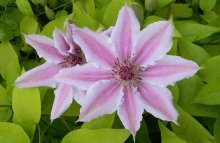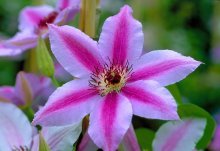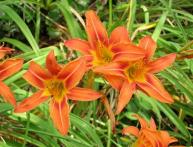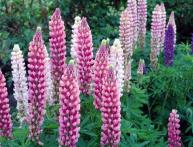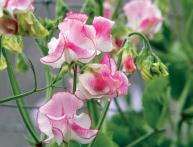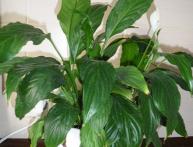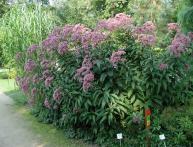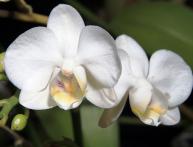Clematis Nelly Moser: characteristics of the plant and growing techniques
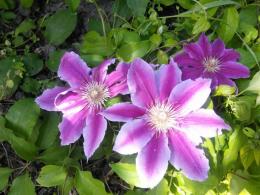
Clematis is a perennial vine that is increasingly becoming popular among gardeners. This plant is difficult to care for, so in order to achieve lush flowering, you should know the features landings and care for clematis.
Content:
- Description of the plant
- Growing clematis: soil preparation and planting
- Clematis care
- Features of reproduction
Description of the plant
Clematis is a shrubby vine more than 2 meters high. The leaves have tendrils, thanks to which the plant grows on a support. The leaves are opposite, trifoliate, oval green.
The Nellie Moser variety has star-shaped flowers, about 18 cm in diameter and purple and light pink in color. One flower has from 4 to 8 petals. The petals have bright purple stripes. Flowers appear first on last year's shoots, and then on new ones.
Flowering begins in early summer and lasts until the first frost. Re-blooming may occur. Clematis grows in sunny and sheltered areas. The root system of the plant is quite sensitive to high temperatures. For this reason, when planting, it is important that the neck is located in the shade. Clematis is good grow near fences, trellises, gazebos or other supports.
Growing clematis: soil preparation and planting
Clematis prefers loose, loamy and fertile soils.The soil must be neutral. In windy areas, shoots break and become tangled, and flowers are often damaged. It is not recommended to plant the plant in lowlands, wet and marshy areas. The plant will not grow in wet, clayey or acidic soils.
Bare-root clematis is planted in spring or autumn. Immediately before planting, you should dig a hole measuring 60x60 cm. Next, lay a 10 cm layer of expanded clay on the bottom, and then fill it with fertile soil. Compost, peat, sand and wood ash are used as substrate.
It is also necessary to add 10 g of superphosphate and about 200 g of lime to the soil. Mix everything thoroughly. First immerse the roots of the plant in cool water for 1.5-2 hours, and then carefully straighten them and deepen them into the soil by 10 cm. After that, water them with water.
plant Clematis should always be planted near a support. Its height should be about 3 meters. It is not advisable to plant close to a wall, fence or other support. The distance from the support to the plants should be about 10-15 cm. When planting clematis next to other plants, a distance of 1 meter must be maintained.
Clematis care

The liana should be watered promptly and abundantly. It is important to avoid stagnation of moisture. Watering is done once a week, and during drought at least 2-3 times. It is recommended to fertilize the plant once every month and a half, alternating mineral complexes with organic fertilizers.
Pruning clematis will help create a beautiful shape and fullness of the plant. To do this you need:
- The first time clematis is pruned is when planting. In the summer, shoots that are formed from the lower buds are pinched. The plant is then pruned regularly.
- For lush flowering all summer, in the spring some of its shoots are cut off.
In late autumn, the plant should be prepared for winter. His trimmed, cleaned and covered with boards or other objects with the first frost. With proper shelter, the plant can tolerate frosts up to 45 degrees. The greatest danger for clematis is not frost, but waterlogging of the soil.
In the spring, the plant is pinched, the shoots are pruned and, if necessary, replanted at a distance of 0.5 meters from each other.
Features of reproduction
Clematis can be propagated in several ways:
- Cuttings
- By layering
- Seeds
- Dividing the bush
When the buds begin to set, propagation can be carried out by cuttings. To do this, cut the shoots and divide them into parts, while the lower cut should be oblique. The segments must have one node each. Leaves trimmed half. Prepared cuttings are planted in a substrate and placed in a warm place.
They need to be watered regularly. After the cuttings take root, they are planted in a greenhouse along with a pot. The shoots are planted in a permanent place after a year. Reproduction by layering is carried out as follows: the bush is hilled in such a way that 2-3 ovaries are underground. After a couple of years, a root system will begin to form in place of the leaves.
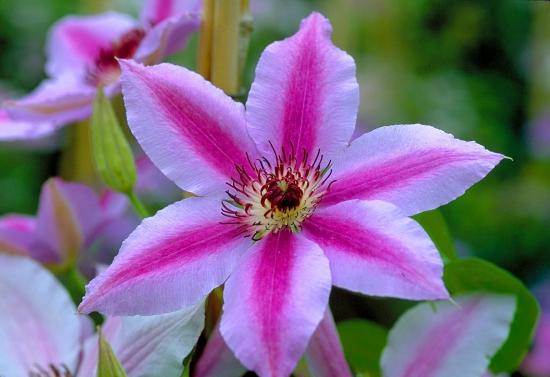
After this, the shoots with new roots formed are cut off. There is another way of propagation by layering: dig a small ditch near the vine bush and lay a couple of shoots. Next, sprinkle with peat and soil, and cover with dry leaves on top.
The seed method of plant propagation is used only for small-flowered varieties; other species can be propagated using the methods listed above.You can collect the seeds yourself: small-seeded varieties produce seeds in 1-2 months, and large-seeded varieties produce seeds in 2-3 months.
Sowing of seeds is carried out in open ground with the onset of warm, stable weather. Shoots will appear in 1.5-2 months. Previously seeds need to be soaked in warm water for 3 days. To improve germination, it can be treated with special means. Dividing the bush can be done in young plants.
The bush needs to be dug up, the roots shaken off the ground and divided into several parts with pruning shears. It should be divided in such a way that enough roots and shoots with buds remain on one division. Before planting, it is recommended to treat the roots of the plant with potassium permanganate. When choosing a method for propagating clematis, you should take into account the plant variety, as well as its age and condition.
Video about what clematis flowers "Nelly Moser" look like:

